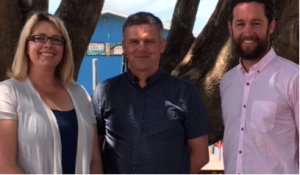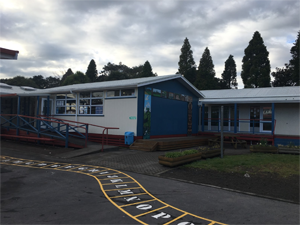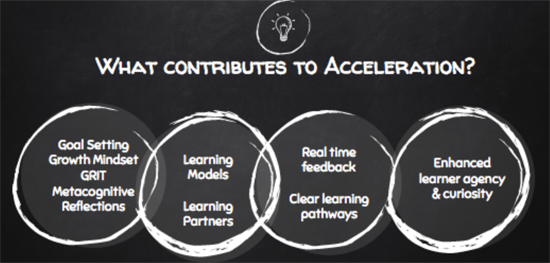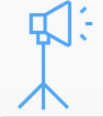Cushla Young and Ryan Fleming share a year 5/6 class at St John Bosco School, an integrated Catholic Primary School for boys and girls inclusive of year 1–6, located in New Plymouth.
Photo: Cushla and Ryan pictured with principal Dee Luckin (centre)
Cushla and Ryan have been focusing intently on learner agency for 18 months, across the whole school, setting up systems and processes to release control and, basically, get out of the way of their students using digital technology as the accelerator.
This is their journey towards collaboration: in planning, teaching, reflection, and assessment.
What does learner agency mean to you?
- Giving clear pathways that students can follow that are guided by the teacher and monitored by students and teachers and shared with parents.
- Giving students scaffolded choice of contexts, next learning steps, and different ways to embed learning.
- A focus on foundational skills and learning behaviours for successful, personalised learning.
- Students working at their own pace and teachers getting out of the way.
Why did you decide to focus on learner agency in your classroom?
We wanted:
- to remove the ceiling for students and support them to accelerate their learning
- more collaboration both between teachers and between teachers and students
- to prepare our students, in particular, on deep learning competencies
- students to know in a deep way where they were at, what they should learn next, how they could learn this best and how to reach beyond what they think they can do (growth mindset).
Our curriculum has, over the years, become crowded. Authentic agency maximises teaching and learning time. It frees the facilitator/teacher to focus on deliberate acts of teaching. Agency, and having scaffolds or pathways in place, truly supports learners needing support and allows multiple opportunities to master the concept, but it also gives scaffolded freedom to allow others to pick up the pace of their learning and achieve far more than we often achieve in a typical traditional classroom.
Effective pedagogy
Cushla and Ryan have considered their use of effective pedagogy to support student agency. They have created a supportive learning environment with structures and systems in place that allow students to encounter new learning a number of times and in a variety of different tasks or contexts. Students can progress at their own pace which maximises the use of learning time.
What were the first steps to develop learner agency?
We began with our trackers and digital hubs. We had clear formative assessment that informed the learning pathway for the teacher and for the student. We had high expectations at the beginning and clear monitoring processes. Students shared their learning on Seesaw.
Example of a maths tracker:
It was important to equip students with devices to enable their agency.
“In 2016 we piloted 1:1 iPads in four classrooms. Teachers were placing pressure on me, saying that they couldn’t get traction with one iPad between two or three students. The Board quickly approved the purchase of enough devices to ensure each child had their own iPad in each of the four classes.“
Principal, Dee Luckin
Alongside this we had detailed learning pathways, next steps or digital hubs for our tamariki. Early on, I saw students asking teachers if they could remove themselves from class and work on the hub or slide somewhere quiet. I watched them closely and realised that what they were showing me was "agency", they wanted to be in control of their learning and were putting themselves in a position to deepen their learning without the control of the teacher slowing or hindering their pace. This I believe was the start. It was an incredibly open type of learning with not a lot of accountability, which was yet to come in the form of trackers and integration of formative assessment practices.
Learning to learn principle
Cusha and Ryan are encouraging their students to reflect on their own learning processes and 'learn how to learn'. As their students have become more self regulated learners, Cusha and Ryan have facilitated an effective learning environment that allows students to exercise greater agency.
What have been the most successful strategies used?
Implementing and developing:
- Senior Learning Hub: a site where students go to find schedules and their rotations
- Maths Hub: a site which has a learn it/practice it/prove it model with videos, follow up work and prove it tasks
- trackers which students use to monitor their pathway
- the deliberate teaching of growth mindset and GRIT and using this to teach dispositions
- Literacy Hub: just like the Maths Hub but for literacy
- conferencing with students on their levels, progress, and next steps
- student understanding and appreciation of what a professional and personal digital profile looks like and how we should be seen online.
Learning to learn model
One of the key competencies that is required for learner agency to be successful is the self-regulation of the learner:
- the ability to focus
- to be accountable
- to follow a pathway.
For example, in writing, one teacher is in front with most of the class while the other sits down with priority learners and extension writers close by. Both teachers are working from the same literacy plan modelling how to learn, for example, Think, Pair, Share. The teachers verbalise the "thinking" and model the pairing up and sharing. As time goes on, the teacher with the students needing more support intentionally does less, with the students doing more. That teacher can indicate to the main group if priority students have something to share. That way the teacher can refocus on learning with the priority learners, then move onto the extension group. We have found students are more accountable and more likely to work independently.
“Scaffold that release of responsibility.”
“Children are now verbalising their learning, which is a lifelong strategy and means they understand how to learn.”
Principal Dee Luckin
Importance of rigour, high expectations, and growth mindset
Learning is not the result of teaching but if the children aren’t willing to or motivated to put in the work it’s not going to happen. Our students are now exposed to new learning when they feel they are ready. They’re not having to wait for the teacher. We also encourage students to try the next level up, and they are rewarded for working hard. We celebrate learning from our mistakes. We can be relentless because we have the structures in place. We talk a lot about consolidation and really embedding the learning.
We intentionally taught growth mindset and grit and being in the "learning pit" and what students need to do to get out of that pit. Our children weren’t great risk takers, but they’re using that risk taking language more now. They know it’s okay for learning to be a little hard. A growth mindset culture will ensure they don’t see each other as a threat, but as an inspiration. We can quickly have one-on-one conferences to follow up. Every Friday we have coaching conversations.
Executive functioning is the ability to recall and manage tasks on time. A lot of reasons why students are not achieving is due to poor habits. Some children had become dependent on teacher aides. We’ve been very deliberate about learning behaviours we’d like to see.
High expectations principle
Staff at St John Bosco School are supporting and empowering all students to learn and achieve personal excellence. They encourage their learners to have a growth mindset and give them access to advanced learning opportunities. Risk-taking, managing setbacks, and receiving constructive feedback are regular components of school life.
What have been the biggest shifts in engagement and achievement?
We have a lot more motivated boys who have enjoyed the depth of freedom and competition. The criteria for success is clear. Curiosity is enhanced.
There has been a huge achievement shift in maths and writing. Students are working two stages above where they are expected to be at. The middle "at" kids have shifted to above. Those on the cusp above have moved way above. This has allowed teachers to work alongside priority learners. We have been able to push them along and some have now reached "at" or are slightly under.
Advice for teachers wanting to implement student agency
Collaboration
Having support from a colleague and also management to ensure what you are trying to achieve is actually making a difference. It’s okay to disagree with each other initially, but you need to come to an agreed outcome. Based on this, you need to trust your colleagues. We co-plan, co-assess, co-teach, co-report, monitor and analyse data. We have regular quick informal check ups with each other.
Reflection
You need to regularly reflect on data and outcomes. There needs to be clear formative assessment practices and accountability on students, monitored by teachers. This truly shows whether your structures are having an impact.
“Teachers need to know for sure what impact their teaching is having on students’ learning so we know exactly what’s happening. We can’t just guess, assume or "think" that what we are doing is having impact.”
Principal Dee Luckin
Strong pedagogy
Keep asking yourselves:
- What are the benefits to the students?
- How is this improving my teaching and learning/skills/attitude outcomes?
As we haven’t got a renovated building yet we’ve been able to work slowly and deliberately on the pedagogy.
You’ve got to be open to challenge from your support team. Questioning and clarifying shouldn’t be seen as a personal attack – it should be seen as an opportunity to grow, clarify, and solidify what and why you are doing what you do.
Principal Dee Luckin explains the importance of school culture
Our school has had a big push on valuing achievement and academic excellence as well as celebrating progress. We’ve created a culture that values hard work, being "uncomfortable" and making mistakes. We’re strong on our Catholic values – being honest, kind...
As a staff we share and inquire so we are on the same pathway. This whole school focus means we research, grow, and feed off each other. There’s a willingness from staff and they are ready and confident to "give it a go". We can be as innovative as we want to. Communication has been a key especially to bring parents on board. Our community hasn’t challenged us because of our open communication whereby we’re prepared to discuss and consult. We are all on same learning journey.
Next steps
- Integrating our model across the whole school consistently.
- Moving into a new Innovative Learning Environment (ILE) and fine tuning practices.
For more information, especially on developing systems and processes and the use of trackers and hubs, check out St John Bosco's ULearn17 slides presentation – Learner Agency and Digital Tech.
Visit a mock up of the St John Bosco Senior Learning Hub.
You might like ...
Learner agency spotlight
Use our third spotlight to explore learner agency and find strategies to help you build greater agency in your own classrooms. This spotlight includes short videos, group activities, and opportunities for personal reflection.
- Tags:
- effective pedagogy
- high expectations
- learning to learn
- primary
Return to top




